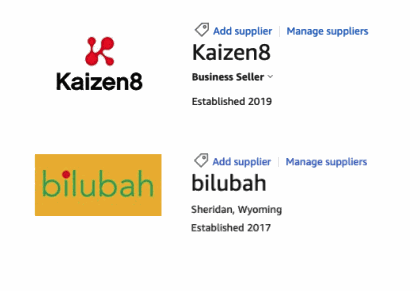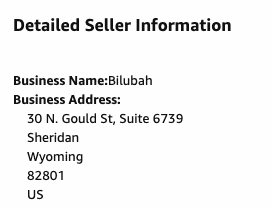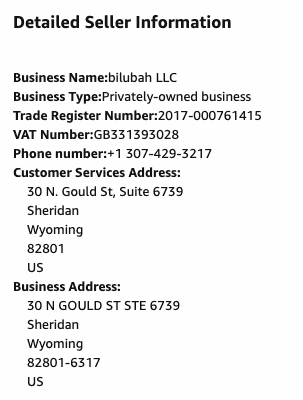Reading time: 7 min
On July 8, 2020, Amazon US announced:
“Beginning on September 1, 2020, we will display a seller’s business name and address on their Amazon.com Seller Profile page. For individuals, we will display the individual name and address.”
It did not happen precisely on September 1, but now the seller address is also visible on Amazon.com.
Amazon’s reason for this change was:
“To ensure there is a consistent baseline of seller information to help customers make informed shopping decisions.”
In reality, the decision is in line with all the programs Amazon launched in recent years to combat counterfeit and unsafe goods. The move is also a response to lawmakers’ and the US administration’s continued pressure on these issues. On January 24, 2020, the Department of Homeland Security (DHS) released the report “Combating Trafficking in Counterfeit and Pirated Goods,” with recommendations for e-commerce companies like Amazon. Among them, there was a request to enhance third-party screening processes requiring various forms of identification.
Finally, removing seller anonymity will not only be about counterfeit and unsafe goods. Brands will have the information needed to enforce approved retailers. Something that was not easy at all, up to now.
.JPG)
What it looks like
When you browse a product page on Amazon, you can see the sellers’ names as links leading to their profile page. The use of DBAs (Doing Business As) permits companies to prevent their identity from becoming public. There can be no relationship between an Amazon seller name and the corresponding legal entity. In the past, when you landed on a seller profile storefront, you could sometimes see a location, in terms of city and state. Not enough for a brand to understand who was selling its products and whom to address for a MAP policy violation.
That was not the case in Europe, Japan, and Mexico marketplaces. There, the seller page had to show much more information.
For instance, in Europe, sellers have to display their VAT (Value Added Taxes) and Trade Register number beyond their address. These numbers are unique identifiers that permit to track back the business or individual selling on Amazon.
You can compare the old Amazon US profile information, the new and the European ones in the following picture.

US Seller Information before Sep 01 2020
On Amazon USA, before September 1, 2020, the maximum available information was the location: city and state. The seller could opt out and do not show anything.

US Seller Information after Sep 01 2020
Since September 1, 2020, the Amazon USA seller profile includes the name of the legal entity or individual that opened the account and the corresponding registered address.

EU Seller Information
The information published on Amazon USA is still reduced compared to the Amazon EU marketplaces.
As required by laws and regulations, the seller has to publish the VAT and Trade Register numbers, the business type. The phone number, optional on Amazon USA, is mandatory in Europe.
As we wrote in our article First: Know Thy Sellers: “It is a strange irony of fate. Europe, with tight privacy rules, does not permit anonymity to sellers. The USA, with more relaxed data protection, enables sellers to hide.” At last, this is not true anymore.
Not Everybody is Happy
All over last July, there was a blossom of online articles about the announced Amazon US change, mainly from the seller’s perspective. Most of them aimed to warn Amazon sellers about the risk of being publicly exposed. Their reading was a source of surprise for me. At bilubah, working not only in the Amazon US marketplace but also on the European one, we are used to seeing our address and legal entity information on the profile page.
Why should a business or an individual seller perceive a public identity as a threat?
The sellers’ comments on those articles are enlightening. They substantially claim the following.
As most Amazon sellers are individuals, publishing their addresses will harm their privacy, divulging sensitive details.
Risk of more harassment and false claims by competitors and predatory legal firms.
Now everybody will know the existence of multiple accounts of the same seller.
Privacy Protection
The privacy protection worry is difficult for me to accept. If you start a business, you enter a public arena. You interact with customers and suppliers. It isn’t straightforward to glimpse a legit reason to hide.
There are more than 400,000 brick and mortar stores in the USA. All of them are dealing with consumers every day. The concern that a crowd of crazies, because they now know your address, will start knocking your door, is paranoid and unprofessional. We do not have information about Mexican, Japanese, or European Amazon sellers in physical danger because customers know their address!
All the blogs’ authors’ solutions are simple: create a business entity, like an LLC, get a business address different from your home one, or get a PO box. The last one, hard to see as a professional and transparent approach, can be tricky. Indeed Amazon verification requires a matching utility bill, and the address on the bank account or credit card statements has also to match.
Harassment and False Claims
The concern of an increased number of harassment and false claims seems more reasonable than privacy but is not. There are indeed rogue brands as rogue sellers. Still, the counterfeits and pirated goods threat outranks by far the risks of false Intellectual Property claims.
Retailers have responsibility for their business. If they have transparent relationships with their vendors, there will not be any harassment.
Discovery of multiple accounts
The anxiety for the possible discovery of multiple accounts of the same business or individual is finally wholly wrong because it regards a behavior against Amazon rules.
Amazon’s Prohibited Seller Activities page reports that you cannot have multiple seller accounts without a legitimate business need.
Legitimate business justifications include:
owning multiple brands with different and separate business entities;
manufacturing products for distinct and independent companies;
being enrolled in Amazon programs that require various accounts.
In any case, a duplicated account must have:
A separate email address and bank account;
Do not sell the same products or services as the original account;
Sell in entirely different categories;
Each account must have its inventory.
In other words, if someone used multiple seller accounts to win additional sales from the competition or to trick Amazon, that is against the rules. Being discovered, in this case, is a justified but not legit apprehension.
What’s in it for brands
Intellectual Property protection on Amazon is an issue. The company has been addressing it over time with multiple initiatives and programs.
Nevertheless, the far most diffused Amazon problem for brands is the violation of pricing policies from unknown sellers.
In reality, the breaking of MAP policies on Amazon is often the tip of the iceberg of an uncontrolled distribution network.
We heard brand owners often saying: “I do not know how they got my products.”
Let’s recall all the ways a product can get on Amazon beyond a brand radar.
Sellers doing Retail Arbitrage (RA) or Online Arbitrage (OA): they buy products at physical or online store sales and resell on the Amazon marketplace at a margin.
Sellers buying your products through a distributor.
Some retailers and distributors are buying directly from the brand but then sell on Amazon under an unknown storefront name.
These three situations have a common factor: somewhere, the brand’s product changed hand without any commitment to its policies.
Under the first sale doctrine, codified at 17 US Code § 109, the buyer of goods bearing a trademark is free to resell them. The limit of this freedom is that the reseller has not to alter the trademark owner’s product.
That means a brand cannot prevent a seller from selling at any price products legally bought.
The only real defense for a brand is establishing well-defined distribution network-wide pricing policies, as MAP or MSRP, and their strict enforcement.
A brand cannot prevent a seller from selling on Amazon under MAP. Still, it is free to close the business relationship at the origin of the violation.
Of course, enforcing rules requires knowledge of the violators. Under this perspective, the end of seller anonymity is good news. Finally, there is a legal entity and an address to verify if the offender is in the company database. Even if the storefront reports a PO box, there will still be a real name, a business entity, or an individual.
Amazon USA’s move will not replace all the work a brand needs to protect its image and products. Still, it will make life easier for the honest players of the marketplace.
Making Amazon a Better Place For All
At bilubah, we welcome the end of Amazon US seller anonymity. We always presented ourselves to brands as a transparent player, with a face, a phone, and an address. We believe in building trustful and mutually beneficial business relationships, not in hide-and-seek games.
With the launch of the Brand Registry program, back in 2015, Amazon initiated a journey that has seen more and more stages to combat IP infringements. The last one being the creation of a new Counterfeit Crimes Unit announced on June 24, 2020. A team dedicated to bringing to justice sellers attempting to list counterfeit products in its store.
Nobody can say that the company has dedicated a similar effort to support brands in fighting unauthorized sellers or enforcing their MAP policies. That leads some commenters to say that Amazon enjoys the price erosion created by rogue third-party sellers. Indeed, in such a situation, Amazon always gains, the final customer is satisfied, is up to the seller juggling for the profit margin, and brands suffer terrible backlashes.
Though born with a different goal, the Amazon July move to disclose the sellers’ legal name and address contributes to making the marketplace a better place. Previously, just obtaining that information was an adventure, often unsuccessful.
A brand’s journey to control its products on the Amazon marketplace is still a long one. At least the step of identifying the sellers will be more straightforward.
Key takeaways
On July 8, 2020, Amazon US announced the availability of sellers’ business name and address on their profile from September 1.
The change goal is to provide customers with a consistent baseline of seller information to make informed shopping decisions.
Amazon move is also a response to the recommendations issued by DHS in January 2020 to fight counterfeits and pirate goods.
Removing seller anonymity will also help brands in identifying rogue sellers violating their pricing policies.
Many sellers have seen the initiative as a threat to their privacy, a source of false claims, and a way to identify double accounts.
Sellers’ concerns are unjustified when not wholly wrong, like double account protection, a practice explicitly against Amazon rules.
Even though Brands will still have to use IP protection practices and distribution network control, sellers’ identity discovery will not be an issue.
At bilubah, we welcome the end of Amazon US seller anonymity to improve its marketplace fairness.

No More Amazon Anonymous Sellers
Now also Amazon US made visible sellers’ address on their profile page
Amazon Brand Protection Counterfeits IP Protection MAP MSRP Pirate Goods Third-Party Sellers Unauthorized Sellers Unsafe Products